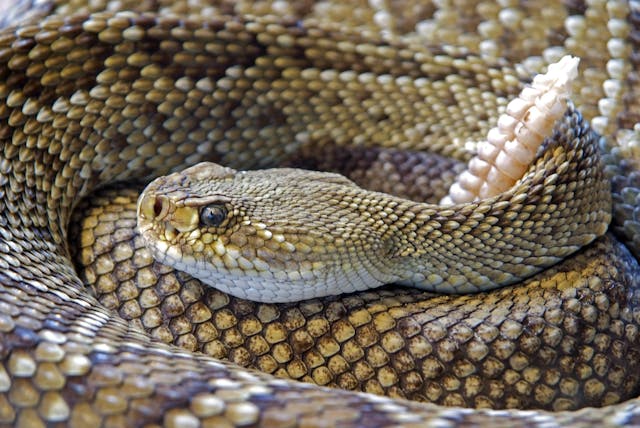
How does a rattlesnake rattle? They have loose hollow scales on the tips of their tails that strike each other when the rattlesnake rattles its tail.
Rattlesnakes are a type of viper and are venomous snakes. There are many different types of venomous snakes, and they are divided by the position of their fangs and how they inject their poison. Vipers have hinged fangs at the front of their mouths. When they bite, the muscles in their mouth pull the fangs into position, and the fangs are folded away the rest of the time. Then there are elapids, such as cobras, which have fangs permanently fixed at the front of their mouths. They also have different types of venom. There are neurotoxins, which attack the nerve system, and then there are venoms which break down tissue or muscle.
All venomous snakes are predators, and they use their venom to kill or paralyze prey so that they can eat it. However, they don’t usually use their venom to kill larger animals because there is too much risk to them. Their venom might be able to kill or paralyze a large animal, but it wouldn’t work quickly enough, and the large animal would have plenty of time to kill them. They would also use a lot of energy that they can’t afford to lose. Snakes are cold-blooded, which means they need to warm themselves up by lying in the sun or warm places. An advantage of this is that they don’t have to eat very often because they have very slow metabolic rates. A disadvantage is that they don’t have a lot of spare energy to use to find food. Trying to take down a large animal would waste a lot of their energy. Snakes are ambush hunters, and they would much rather lie camouflaged in the bush and spring on a small animal at the last minute.
And this is the reason why rattlesnakes have a rattle and nearly all snakes hiss. Venomous snakes will bite and attack if they have to, but they would much rather be left alone. Rattling and hissing are a sign to large animals that there is a dangerous animal in the vicinity, and they should steer clear. Many snakes lie out in the sun, and it is very easy for them to get trodden on by much heavier animals. To avoid this, they hiss or rattle. This type of signal is called an aposematic signal. Brightly colored poison dart frogs are another example of an aposematic signal. They want to stand out as much as possible so other animals avoid them.
So, how does a rattlesnake rattle? Well, the rattle is different to a baby’s rattle in that there is nothing inside it. The rattle sound is created by segments of hardened scales that are hollow and loosely fastened so that they can knock against each other when the snake shakes its tail. All snakes shed their skin a few times a year, depending on several factors. They do this to remove parasites that might be stuck to it, fix any damaged scales, and bring up a new layer of scales that haven’t been worn due to contact with the ground. Unlike all snakes that shed the entire layer of skin, rattlesnakes keep one piece of skin at the very end of their tail. When they are born, they have a single rattle at the end of their tail. Each time they shed their skin, they develop an extra rattle. They shed their skin about four times a year and they can live for up to 25 years, but their rattles don’t just keep getting longer and longer. The rattles break off, get damaged, or are sometimes eaten by insects, so they are always being renewed.
Rattlesnakes vibrate rather than shake their tails. They can vibrate them at about 50 times a second, and the muscles that do this are some of the fastest firing muscles of any animal. When a danger is getting closer, they will start to rattle their tails slowly, giving the first warning. If the danger keeps getting closer, they will start to increase the speed of the rattle, making the noise louder. If the animal keeps getting closer, they will gradually ramp up the speed of the rattle, which gives the impression that the snake is moving towards the animal, even though it isn’t. This is usually enough to warn off any animal. However, there are animals that eat rattlesnakes. They are eaten by owls, eagles, and other birds of prey. They are also eaten by coyotes, foxes, and some other animals. Some other snakes have also been known to eat rattlesnakes. So, even though the rattle is a pretty good warning signal, sometimes it can alert prey. And this is what I learned today.
Photo by Pixabay: https://www.pexels.com/photo/diamond-back-rattle-snake-36714/
Sources
https://animals.mom.com/rattlesnakes-predators-7915.html
https://www.petmania.ie/why-do-snakes-shed-their-skin
https://en.wikipedia.org/wiki/Snakeskin
https://www.thesprucepets.com/reasons-why-snakes-hiss-5215794
https://snakesarelong.blogspot.com/2013/09/basics-of-snake-fangs.html
https://www.britannica.com/animal/viper-snake
https://www.livescience.com/animals/snakes/how-do-rattlesnakes-rattle
https://mdc.mo.gov/blogs/discover-nature-notes/rattlesnake-rattles-2
